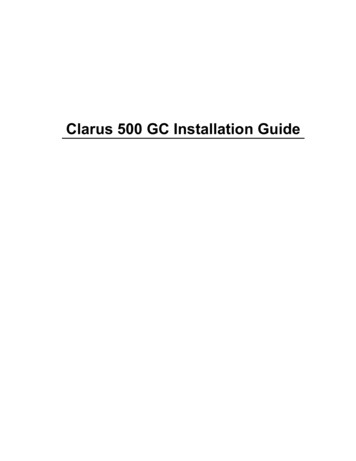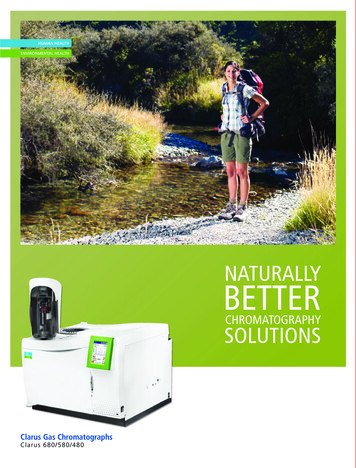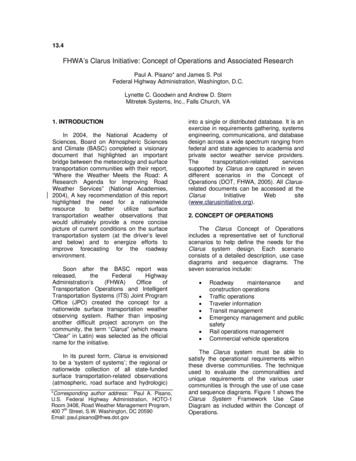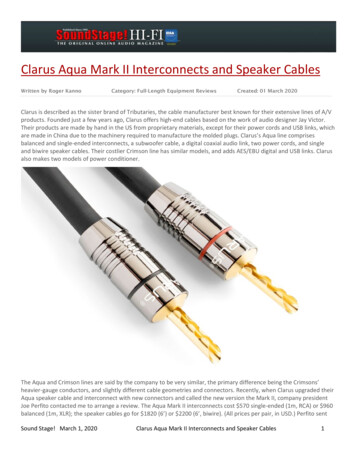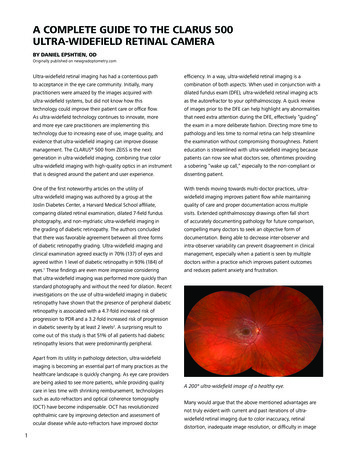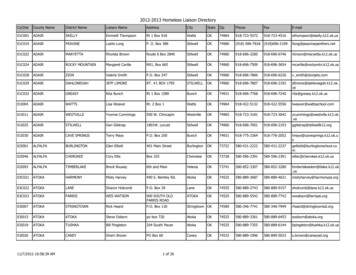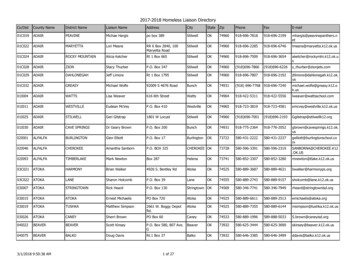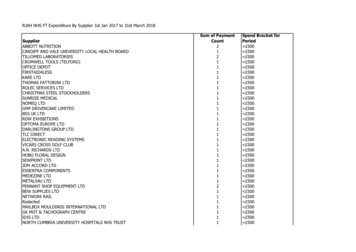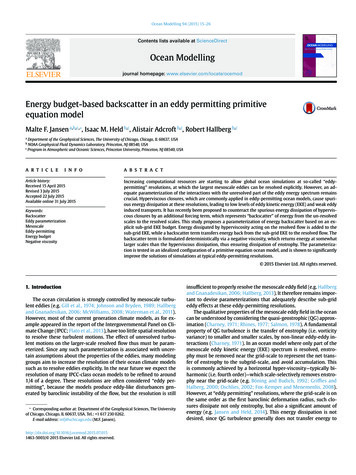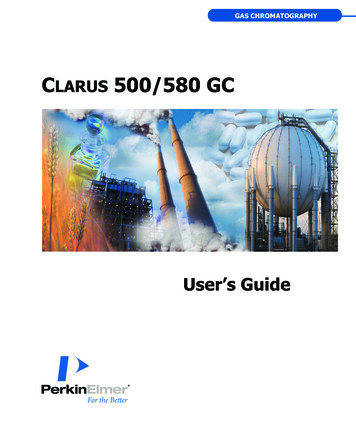
Transcription
GAS CHROMATOGRAPHYCLARUS 500/580 GCUser’s Guide
Clarus 500/580 GCUser’s Guide
Release HistoryPart NumberReleasePublication Date09936625CFebruary 2010Any comments about the documentation for this product should be addressed to:User AssistancePerkinElmer, Inc.710 Bridgeport AvenueShelton, Connecticut 06484-4794U.S.A.Or emailed to: info@perkinelmer.comNoticesThe information contained in this document is subject to change without notice.Except as specifically set forth in its terms and conditions of sale, PerkinElmer makes nowarranty of any kind with regard to this document, including, but not limited to, the impliedwarranties of merchantability and fitness for a particular purpose.PerkinElmer shall not be liable for errors contained herein for incidental consequential damages inconnection with furnishing, performance or use of this material.Copyright InformationThis document contains proprietary information that is protected by copyright.All rights are reserved. No part of this publication may be reproduced in any form whatsoever ortranslated into any language without the prior, written permission of PerkinElmer, Inc.Copyright 2010 PerkinElmer, Inc.TrademarksRegistered names, trademarks, etc. used in this document, even when not specifically marked as such,are protected by law.PerkinElmer is a registered trademark of PerkinElmer, Inc.ii
2Table of ContentsIntroduction .1-1About This Manual .1-3Conventions Used in this Manual .1-4Warning Signs on the Instrument.1-5Screen Abbreviations .1-6Glossary of Clarus GC Terms .1-7Autosampler Terms .1-8Instrument-Specific Terms.1-9Glossary of Chromatographic Terms .1-11Touch Screen Navigation .2-1Chapter Overview .2-3Touch Screen .2-4Navigation Bar .2-17Injectors .2-18Oven .2-31Aux Zone .2-32Detectors .2-33Timed Events .2-49Using the Active Method .3-1Overview .3-3Editing the Active Method .3-4Getting Ready to Edit the Active Method.3-5Setting Up Oven and Inlet Temperature Programs .3-6Setting Injector Temperatures .3-14Viewing/Setting Carrier Gas Pressure/Flow/Velocity .3-21Setting the Septum Purge Mode and Offset .3-33Setting Up Valves .3-41Set up the Splitless Mode for a CAP or PSS Injector .3-49Contolling the Autosampler .3-62Setting Up the Detectors .4-1Overview .4-3FID Overview .4-5Setting up an ECD .4-28Setting up a TCD .4-43Setting up a PID .4-54Setting Up a PID and EICD in Series .4-67Setting Up a NPD.4-80Setting up a FPD .4-99Detector temperatures .4-128Setting the Range .4-130iii.
Changing the FID, PID, or NPD Range During a Run .4-131Setting the TCD Current (Filament Current) .4-133Changing TCD Polarity During a Run.4-135Routing Detector Output .4-137Attenuating Detector Signals Going to a Recorder .4-141Optimizing a Detector Signal to an Integrator for Maximum SampleDynamic Range .4-143Matching Detector Signals with Your Integrator .4-144Autozeroing a Detector .4-146Using the Method Editor .5-1Method Editor .5-3Method Edit Mode .5-5Overwriting the Active Method .5-9Using the Tools Menu .6-1Tools Menu .6-3Method Editor .6-4Event Log .6-5Maintenance .6-7Configuration .6-9Oven .6-19Connecting the PPC Modules .6-38Calibrating the Flow Readout Using Manual Pneumatics .6-67Calibrating the Oven Temperature.6-74Utilities.6-82Release .6-93Reset .6-94Logout .6-95About .6-96Setting up a Typical Analysis .7-1System Status Screen .7-4Injectors .7-6Detector .7-10Detector .7-15Autosampler .7-19iv
Introduction1
Introduction1-2
Clarus 500/580 GC User’s GuideAbout This ManualThis guide is divided into following chapters:Chapter 1 IntroductionThis chapter contains a brief introduction to the instrument, the conventions andwarnings used in the manual.Chapter 2 Touch Screen NavigationThis chapter contains information that introduces you to the look and feel of thetouch screen. It shows you how to turn on the GC, check the status, and performfundamental operations such as changing parameters, selecting options, using thetools menus, etc.Chapter 3 Active MethodThis chapter contains step by step explanation of the active method. Detailedinformation on setting up the autosampler is contained in this chapter.Chapter 4 Setting Up the DetectorsThis chapter contains detailed information on setting up the detectors.Chapter 5 Using the Method EditorThis chapter describes how to modify, save and use the method editor.Chapter 6 Using the Tools MenuThe chapter contains detailed information on the tools menu section of the touchscreen.Chapter 7 Setting Up a Typical AnalysisThis chapter contains information on how to run a typical analysis on the ClarusGC using the most common configuration.1-3
IntroductionConventions Used in this ManualNormal text is used to provide information and instructions.Bold text refers to text that is displayed on the screen.All eight-digit numbers are PerkinElmer part numbers unless stated otherwise.Notes, cautions and warningsThree terms, in the following standard formats, are also used to highlight specialcircumstances and warnings.NOTE: A note indicates additional, significant information that is provided with someprocedures.CAUTIONWe use the term CAUTION to inform you about situations thatcould result in serious damage to the instrument or otherequipment. Details about these circumstances are in a box like thisone.We use the term WARNING to inform you about situations thatcould result in personal injury to yourself or other persons. Detailsabout these circumstances are in a box like this one.WARNING1-4
Clarus 500/580 GC User’s GuideWarning Signs on the InstrumentFor detailed safety information see the Safety Practices chapter in the Clarus500/580 GC Hardware Guide (09936591).Caution, hot surface.Caution, risk of electric shock.Caution, laser radiation hazard.Caution (refer to accompanying documents).1-5
IntroductionScreen AbbreviationsAUX – Auxiliary zoneCap – capillary split/splitless injectorCmptr – computerCtrl – syringe control parametersECD – Electron Capture DetectorElCD – Electrolytic Conductivity DetectorFID – Flame Ionization DetectorFPD – Flame Photometric DetectorGen – generateInj/Vial – injections per vialInt – integratorkPa – kilopascalsNPD – Nitrogen Phosphorus DetectorPID – Photoionization DetectorPkd – packed injectorPOC – Programmed On-Column Capillary InjectorPPC – programmed pneumatic controlPre – # of preinjection syringe washesPsi or psig – pounds per square inch (gauge)PSS – Programmed Split/Splitless Capillary InjectorTCD – Thermal Conductivity Detector1-6
Clarus 500/580 GC User’s GuideGlossary of Clarus GC TermsThe glossary of Clarus GC terms are divided into two types: Autosampler Terms Instrument-Specific Terms1-7
IntroductionAutosampler Terms1-8TermDescriptionWashesWashing the syringe.PreThe number of prewashes of sample to prime the syringe (nopumping).PostThe number of post injection syringe washes with a solvent.PumpsThe number of times the syringe draws up sample andevacuates it before acquiring the volume. This is done toeliminate bubbles.ModeThe style of injection.FastFast speed of the syringe during sample injection. This isused to eliminate discrimination in the needle.NormalNormal speed of the syringe during sample injection.SlowSlow speed of the syringe during sample injection in order toinject directly into a wide-bore capillary column, in hotinjection port.
Clarus 500/580 GC User’s GuideInstrument-Specific TermsTermDescriptionBackgroundcompensationA routine that automatically subtracts a stored calibratedbaseline profile from the signal generated during a GCrun.BallisticallyChanging the oven temperature as quickly as possible toreach a set point.DetectorbackgroundThe detector output signal when no components arebeing eluted.EquilibrationThe delay time after the method set points have beenreached before the system becomes READY.FlameoutPPC version only. Detects if the flame is on to preventinjection into a nonfunctioning system and subsequentloss of sample.IsothermalmethodA method in which the oven temperature remainsconstant throughout a GC run.MethodA collection of parameters that control the GC.Negative-timeeventA timed event that you set to occur before theinstrument becomes READY.ParameterAn independent variable used to specify a condition tobe met.PPC Programmable Pneumatic ControlPre-runThe time after equilibration during which negative-timeevents are executed.PreVent PPC version only. Sample management system.1-9
Introduction1-10TermDescriptionRangeFor a Flame Ionization Detector, range meansamplification of the detector output signal.ReadyIndicates that all method parameters have reached theirset points and that you can start your analysis.RunThe time from sample injection to the end of the oventemperature program.Sleep modeThe GC can be set to a predefined method for gassavings.TemperatureprogramPPC version only. A program that specifies the rate ofoven temperature increase from one plateau to the next,and the time the oven temperature is held constant at aplateau.Timed EventsEvents that take place before or during a GC run asspecified in a timed events table.ZoneA heated area in the GC oven, injector, or detector.
Clarus 500/580 GC User’s GuideGlossary of Chromatographic Terms*Adsorption – A process that occurs at the surface of a liquid or solid as a result ofthe attractive forces between the adsorbent and the solute. These forces may bephysical or weakly chemical.Analysis – The complete investigation of a sample by gas chromatographicseparation including identification of the sample components and quantitativemeasurements.Anode – The negatively charged electrode in any electrical circuit to whichcharged particles and ions are attracted.Band Broadening – A process that occurs in the GC whereby the peak width fora component increases the longer the component travels through the column.Baseline – The detector signal to a recorder or integrator when only the carriergas is passing through the detector.Baseline drift – Any regular change occurring in the baseline signal from thedetector, usually resulting from column temperature and/or gas flow changes.Blank run – A run without the sample being injected.Bleed – The evaporation of the stationary phase from a column.Capillary column (wall coated open tubular column) – A small-internal-diametercolumn whose inside wall is coated with a liquid phase.Carrier gas – The mobile phase of the separation system. An inert gas whichtransports the sample from the injector through the column to the detector. Thisgas is usually helium, hydrogen, or nitrogen.Column conditioning – A process for producing a stable column by heating thecolumn with carrier gas flowing to remove volatile impurities from the stationaryphase.Detectors – Hardware that responds to sample components producing anelectrical signal that can be measured to quantitate the amount of eachcomponent present.Flow programming – The stored PPC program is interpreted as real columnmass flow settings or capillary column flow settings from which the inlet*Reference: Denney, R.C. A Dictionary of Chromatography.1-11
Introductionpressure is calculated. This is dependent on the capillary control mode andinstalled pressure or split control option.Flow rate – The mass flow of carrier gas or detector gas in milliliters per minute.Ghost peaks – Peaks that are not due to sample components, for example, peaksproduced by carrier gas impurities, septum, or components from previousanalyses.Injection port – The hardware through which the sample is introduced to thecolumn by injection.Linearity – Quantitatively all detectors will produce a linear response withrespect to solute concentration over a defined range, for example, the LinearRange.Liquid phase – The material in the column that causes the components toseparate because of partitioning of the components between the mobile phase(carrier gas) and the stationary phase (liquid phase).Lowest limit of detection – The smallest amount of sample that can be detectedby the detector being used. Usually defined as any signal that is as great as twotimes the noise level. Also referred to as Minimal Detectable Quantity (MDQ).Mobile phase – The gas which carries the solute (sample) along and over thecolumn material. This carrier gas is inert and usually helium, nitrogen, orhydrogen.Noise – Background signal fluctuations arising from a detector response. Thisresponse is the result of the column installed, carrier gas purity, electroniccomponents, etc. The response of any detector is defined by the signal-to-noiseratio.Partition Coefficient – The differential solubility of a substance in two differentphases. In the case of gas–liquid chromatography, the sample components reachan equilibrium between the gas phase (mobile) and the liquid phase (stationary).Each component has a different partition coefficient thus causing separation inthe column.Pressure programming – Pressure control through an independent four-step,three-ramp program for each carrier gas channel.Resolution – The degree of separation between two peaks.Retention time – The time interval from the point of injection to the appearanceof the peak maximum, of a component’s signal.1-12
Clarus 500/580 GC User’s GuideSeptum – Silicone rubber material placed in the injection port through which theinjection is made. When the needle is withdrawn, the silicone rubber reseals,thus not allowing any sample or carrier gas to escape.Stationary phase – The liquid or solid adsorbent portion of the column thatretains components passing through the GC column.Subambient – Below ambient temperature. The oven cools down below ambienttemperature with the use of either liquid nitrogen or liquid carbon dioxide.Syringes – Precision dispensing devices used to deliver sample to the GC.Liquid and gas syringes are available.Tailing – When a peak is not symmetrical or Gaussian shaped but the back end isbroadened, it is said to be tailing.Temperature programming – A technique commonly used to increase the rate ofelution of the components. After the sample is injected into the oven at a specifictemperature, the temperature program increases the oven temperature to theprescribed temperature at a defined rate (in C/min).Unretained peak – A component that is not retained by the column. The timetaken for an unretained sample to pass through the column is the same time as thetime taken for the carrier gas to pass through.Velocity programming – Programmed linear velocity where the PPC controllerinterprets stored PPC programs as the average capillary column linear velocitysettings.1-13
Introduction1-14
Touch ScreenNavigation2
Touch Screen Navigation2-2
Clarus 500/580 GC User’s GuideChapter OverviewYou operate the Clarus GC using the touch screen. The touch screen is theinterface between you and the instrument, enabling you to control the Clarus GCin order for you to perform your analyses easily and conveniently. The touchscreen contains active areas that you touch to perform the required action.You may find it more convenient to use a stylus or you may like to touch theactive areas of the touch screen. Do not use sharp, pointed objects.A light touch is all that is needed. You do not need to press forcefully on anactive area.Please note that when you touch an active area, various processes are started inthe instrument. Some of these processes may take several seconds. Be patient andwait for the process to complete before touching another active area on the touchscreen.This chapter gives a brief overview on touch screen definitions and navigation.For details on using the active method, method editor and tools menu seechapters 3, 4 and 5.2-3
Touch Screen NavigationTouch ScreenThe main display area on the touch screen are referred to as screens. You usevarious screens to set up your Clarus GC to perform the analyses. These screenscontain: Entry fields which allow you to make entries, Buttons that you touch to start or stop actions or to display a dialog, Option Buttons that you select drop down menu options from a list, Boxes that you use to switch functions on or off and Radio Button that allow you to choose one of two or more options.The Clarus GC is controlled by a collection of operating parameters called theActive Method. You can prepare and save up to five methods and make any oneof them the Active Method. However, the fifth method is reserved forTotalChrom and may be overwritten.The following Status screen shows the different sections of the user interface.The Status Screen displays icons that provide quick access to major areas of thesystem. The injector and detector buttons show graphic representations of thedevices for each channel. If a heated auxiliary zone is configured, the Aux buttonwith a thermometer appears active on the bottom of the screen. The Aux zonebutton with the carrier gas icon indicates the PPC carrier gas zone is active. Theicon buttons that represent the heated zones (injectors, detectors, oven, and Auxif configured) include a light to indicate the ready/not ready status. A redblinking light indicates not ready and a steady green light indicates ready status.2-4
Clarus 500/580 GC User’s GuideThe Title bar displays thename of the active.The Run button providesaccess to the Autosamplerand Manual Inject settings.Channel B appears on top ofChannel A to emulate theorder on top of the GC.Click here to view the Signal. Ifa method is not running thescreen will display a baseline.The Icon buttons provide quickaccess to all configured areas ofthe instrument. An indicatorlight shows the ready/not readystatus of each heated zone.The status bar displays theoverall ready/not ready status aswell as text messages and thereal time clock/date display.The bottom bar displays theTools pop up menu. When thesystem is running the Stopbutton also appears.2-5
Touch Screen NavigationTabsSome of the active method screens include tab to allow you to switch viewsassociated with a specific channel.Non-Configured DevicesIf a device is installed but not configured, or configured as None, the graphic andlight are grayed out.Touching the button prompts the following dialog box.The following capture shows the drop down list on the injector configurationscreen to set a device as “None.”2-6
Clarus 500/580 GC User’s GuideNon-installed DevicesIf a device is not installed, a grayed out deactivated button with no indicator lightappears in the designated position.Touching the button prompts the following dialog box:2-7
Touch Screen NavigationRun ButtonThe Run icon displays the Manual injection and Autosampler settings if thedevice is enabled. The bottom bar on these screens includes the Start button.When the system is running, the Start button changes to the Stop button. Sincethe Start button is only available on the Autosampler and Manual inject screens,you must initiate a run from these screens. However, when the system is running,the Stop button appears on all screens allowing you to Stop the run fromanywhere in the application. If the system is Paused, the Resume button appearson all screens.AutosamplerWhen an Autosampler is enabled, the Run button defaults to that screen. Thefollowing screens shows the enable check box on the configuration screen andthe associated Autosampler screen in the Active Method.2-8
Clarus 500/580 GC User’s GuideWhen the instrument is ready, touch the Start button to begin the run. If youtouch Start before the system is ready, the run will start when the system reachesthe ready status.When the Autosampler is disabled, the Run button displays the Manual injectscreen. When the instrument is ready, touch the Start button to begin theanalysis. The countdown enable check box is selected by default. You can stopthe countdown if needed.2-9
Touch Screen NavigationManual InjectionIf no Autosampler is installed or configured, the Run button displays the Manualinjection screen.The enable check box is selected by default. Touching the start button initiatesthe countdown starting from 5 seconds. When the countdown reaches 0, anaudible beep prompts you to inject the sample. The GC will then start to programthe oven and collect data. If the enable check box is deselected, the timer isdisabled and the wording in instruction 3 is modified to exclude the tone. Thesystem starts as soon as the Start Button is pressed and you make an injectioncontemporaneously.2-10
Clarus 500/580 GC User’s GuideWhen the Stop Button is pressed, an abbreviated stop menu appears.Signal ButtonThe Signal icon displays the graphic signal for the active method. If the system isnot running, a baseline appears on the graph.Raw signalProcessed signal2-11
Touch Screen NavigationThe Signal screen displays the selected detector signal over a fixed time period (2minutes) with you selecting the scaling factor. The raw signal is unprocessed andcan appear slightly larger than the processed signal. The processed signal hasgone through an attenuation and offset filters.The name of the channel appears on the top left of the screen. Detector controlsinclude Ignite and Autozero.Zero Display controls include scaling and zeroing.Ignite ButtonPressing the Ignite button starts the ignition sequence for a PPC-enabled FID.During ignition the plot and signal level are active.For information on setting up manual pneumatics for the different detectors seethe various detector sections in chapter 4 “Setting Up the Detectors” and sectionsin Chapter 3 on “Using the Active Method” and Viewing or Adjusting CarrierGas Pressure Using Manual Pneumatics.AutoZero ButtonAutozeroes the selected detector.Signal PlotThe plot graph displays the signal from the selected detector in “real time.” Thewindow is 2 minutes wide. The signal commences at the y-axis and is plotted outto start 1.75 minutes. The signal then scrolls back so the start is now 1 minute,the last 0.75 minutes are displayed from there, and the signal then scrolls outagain.The signal is plotted continually before, during and after a run.Signal Display and ScalingThe signal display at the top of the screen displays the signal level of the detectorin mV.2-12
Clarus 500/580 GC User’s GuideThe default signal scale is 0-1024mV. The up/down arrows will adjust thedisplay between 1 and 1024mV by halving or doubling the current factorZero Display ButtonThe Zero Display button offsets the current signal level to 5% f.s.d. on thedisplay.Heated ZonesThe Status screen displays graphic icons to represent the devices installed in thesystem.Each type of injector and detector is represented with a customized graphic aswell as a text label. Heated zone buttons display a status light indicator in thelower right corner. The indicator lights for individual zones follow the sameconvention as the system status light that appears in the Status bar. Steady greenindicates that the zone is ready. A red blinking light indicates that the zone is notready.2-13
Touch Screen NavigationInjector and Detector ButtonsThe screen is organized with Channel B devices above Channel A to reflect theposition of the channels on top of the GC. Injector and detector buttons displaythe active method settings for each device. Touching a device icon displays theselected screen as well as a row of tabs to allow easy access to the injector, oven,detector, and events for that channel. Touching the alternative channel icon onthe top navigation bar displays the active screen and associated tabs for the otherchannel if it is installed and configured. The active method screens includenavigation icons on the title bar that allow you to access the same elementsavailable from the Status screen.2-14
Clarus 500/580 GC User’s Guide2552-15
Touch Screen NavigationOven ButtonThe oven button provides access to the oven program settings and graph.If both channels are running and the Oven is accessed from the Status screen, itdefaults to Channel A. The oven program screen displays the same tabs andnavigation icons as the injector and detector active method screens.Aux Zone ButtonsIf a heated Aux Zone is configured, pressing the Aux button displays a screenthat follows the same format as the injector screens and shows the currenttemperature.2-16
Clarus 500/580 GC User’s GuideNavigation BarThe nav
Clarus 500/580 GC User's Guide - PerkinElmer . to .
